1204. Fall of New Rome
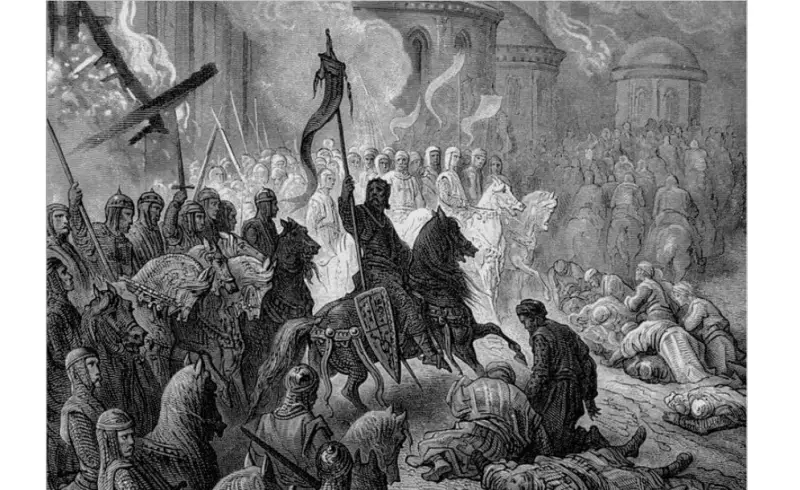
This is a textbook picture from a school textbook. Hood. Paul Gustave Dore. Entry of the Crusaders into Constantinople in 1204.
This article will talk about how for the first time in almost 900 years, external enemies captured the Second Rome.
The previous article ended with Emperor Alexius III Angelos fleeing the capital to the north, towards Bulgaria, leaving the entire population of New Rome in complete confusion. Who, despite the numerical superiority, had no desire to fight the crusaders.
The crowd gathered in the Blachernae Palace, near the crusader camp, decided to return to the throne the younger brother of the fugitive emperor, the blind emperor Isaac II Angel, because of whom all the fuss seemed to be going on. Except, of course, the most important thing - the desire of noble knights and other hired rabble to rob the Greeks.
This was immediately reported to the pilgrim camp, where his son, Alexei, was located.
The Latins did not take advantage of this situation, as Nikita Honian notes, which the Romans were afraid of, because the pilgrims themselves were afraid that the entire mass of the city’s defenders would fall on them. And suddenly they received such a gift of fate, being, as they believed, in such a deplorable state.
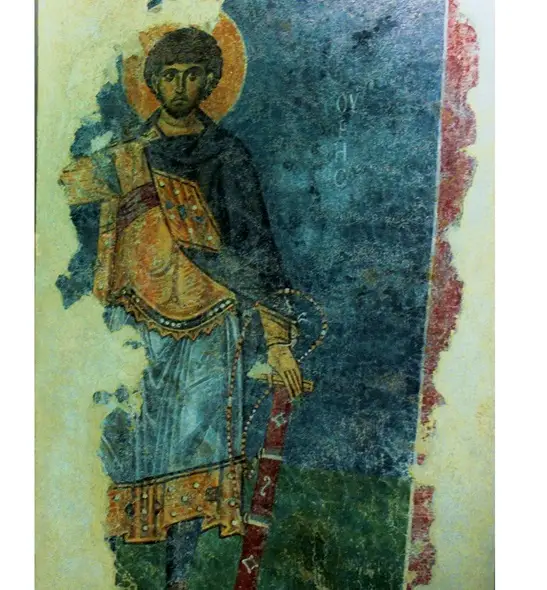
Another Byzantine warrior. St. Mercury. Fresco from the church of the same name. XIII–XIV centuries Archaeological Museum. Istanbul. Türkiye. Photo by the author.
Thus, the crusaders, who walked several times along the razor's edge, received a huge jackpot, in which they undoubtedly saw the support of God, who was on their side, and not on the side of the schismatics and their usurper.
On July 19, 1023, an embassy was sent to the emperor consisting of Mathieu de Montmorency, Geoffrey, Marshal of Champagne (who, as we know, described everything in his work) and two Venetians. They were met at the gates of Blachernae by a guard of Angles and Danes armed with axes, an emperor in an extremely expensive dress and many nobles and smartly dressed ladies.
The Franks demanded that Isaac confirm the fabulous terms of payment for their “labors,” which is why they invaded Byzantium. Isaac, realizing that he could not fulfill them, was nevertheless forced to sign these conditions, sealed with a golden bull.
Fearing clashes, he persuaded the crusaders to station themselves in the Jewish quarter in Galata. Noble barons became frequent guests in the imperial palace; the new Emperor Alexei V often visited the crusaders’ camp, played dice with them and allowed them to treat him with familiarity that was unacceptable to his rank. And Isaac, spending time with astrologers and drinking, indulged in dreams of a great empire, and that the world would obey him.
Despite the fact that all the gold and silver from the churches was confiscated, there was a catastrophic lack of funds to pay. Alexey IV paid 100 thousand marks, of which the Venetians took their half, 36 thousand were paid by the knights for renting ships, and the knights paid the rest of the amount to those who gave them loans, again being left with nothing.
Basileus compensated for the discontent by bestowing gifts on the counts, doge and barons. Ordinary soldiers, as after Zadar, received only crumbs. Things were getting to the point where the pilgrims needed to gather for the Holy Land, the Venetian lease was due fleet ended, as we remember, on September 30, 1203.
And they would have to go to the Holy Land with only part of the amount, hoping and taking hostages, of course, that the Romans would fulfill their obligations.
But then the young basileus himself turned to the crusaders, begging the Franks not to leave him after September 30, so he could raise money for them, and he himself would strengthen his power in the capital. Not all the crusaders wanted to stay here, demanding a march to Syria, but Alexei provided them until Easter 1204.
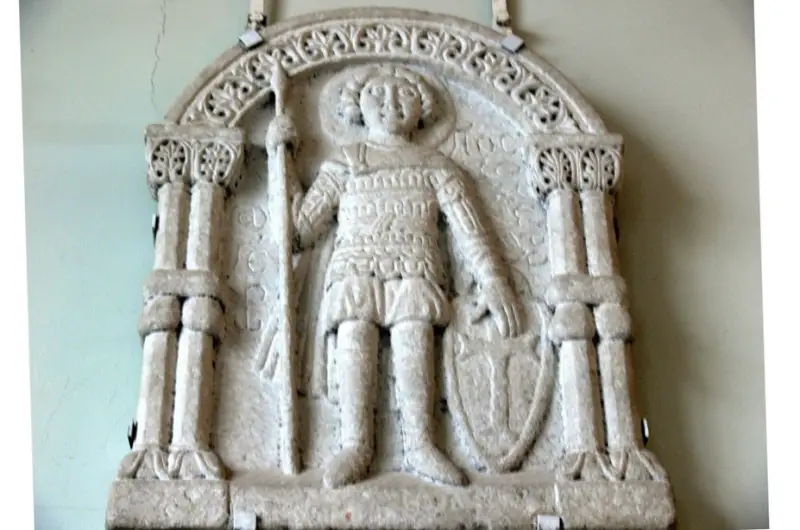
This is what Byzantine warriors looked like in the 13th century. St. George. Stella. Constantinople. XIII century From the collection N. P. Likhacheva. GE. Saint Petersburg. Photo by the author.
Since his uncle, Alexius III, controlled the lands outside the capital, he invited the crusaders to help him recapture cities in the Balkans. Alexius IV subjugated Thrace with the help of the crusaders and returned on November 11, 1203.
While he was on campaign, tensions grew between the Greeks and Latins.
And the townspeople, in such a troubled situation, decided to profit from the Amalfians and Pisans who had long lived among them: a massacre occurred that forced all the Latins to go to Galata to the crusaders, thereby greatly weakening the forces of the Constantinople people.
At this time, the Flemings, Pisans and Venetians decided to profit from the mosque in the eastern part of the city. They arrived by boat from Galata, but met resistance from the Muslims. After which they set the houses on fire in a rage, the wind, walking through the city, fanned the fire throughout almost the entire territory of the capital, it reached St. Sophia, destroying everything that was in the Million area, 100 meters from Sofia, and along the main street - Mese. And then - in all neighborhoods, burning down houses and churches. In the south of the city he reached the city walls on the Propontis (Sea of Marmara) and the Elevtherian pier.
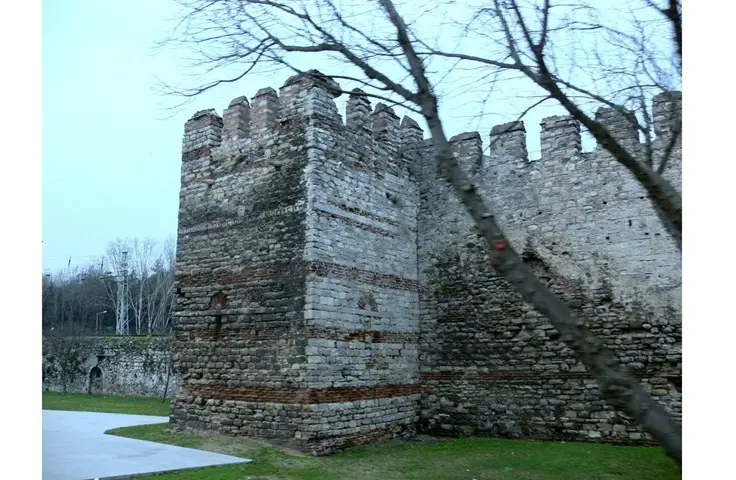
Tower and walls on the Sea of Marmara. Istanbul. Türkiye. Photo by the author.
That is, almost the entire city was burned. The magnificent palace in Blachernae also burned down.
After such events, and also because Alexei IV, after the capture of Thrace, considered that he was sufficiently strengthened on the throne, he decided to refuse payments to the crusaders, however, even if he wanted to, he could not do this.
At first, he was persuaded not to do this by Boniface of Montferan, his knightly sincere supporter, who was advised by “Peter’s legate,” Pope Innocent III.
The next step was taken by an embassy from the pilgrims. It was led by Conon de Bithun, Geoffroy Villehardouin, Molon le Braban and three members of the Venetian council, all girded with swords. Conon de Bityun made a speech to the two emperors, and this speech was incredibly daring. He demanded that all barons abide by the agreement and pay all the money:
Alexei stood his ground, especially since the people of Constantinople were furious with the current situation, and they associated all the problems with the new emperor.
Then the Doge also met with him, who reproached Alexei with the fact that he was ungrateful and would not have taken the throne without the help of the pilgrims. When he received a refusal, Dandolo threatened him that he would become a personal enemy and would not stop until he took revenge. His daring words to the Basileus of the Romans are conveyed by Robert de Clari:
Clashes began on December 1. The pilgrims could not sit idle and plundered the surrounding area. In response, the Greeks attacked them, sometimes successfully. Thus, Alexei Dukas (1140–1205), nicknamed Murzufl (“fused eyebrows”), who was married to the daughter of Alexei III Eudokia (1173–1211), distinguished himself in battles.
The Latins in Galata were in constant combat readiness, because, even having increased their forces at the expense of the Amalfians and Pisans, they were nevertheless significantly inferior to the Romans. Food was high and scarce in the Pilgrim camp.
On January 1, 1204, the Byzantines decided to attack the occupying fleet with fire ships:
But the Venetians were on the alert, they began to save their ships, fighting the fire, it seemed that the entire Golden Horn was burning, and the population of the capital poured out onto the sea walls and joyfully welcomed the fire.
The second attack was carried out 15 days later, but was also unsuccessful. Only one Pisan ship with goods burned down. And the crusaders were again glad that God was on their side, since the death of the fleet would definitely have led to the death of the invaders, who without it would not have had any advantages over the Greeks, because no knightly courage could compensate for the number of forces of the Romans.
At the same time, the capital's residents were actively restoring the sea walls that had been destroyed by the Venetians during the assault of 1203, especially since this assault showed that the walls and towers were not of sufficient height. The Romans raised the walls and strengthened their tops with wooden logs, completed the towers and covered them with skins to protect them from siege weapons, and 40 stone throwers were placed along the walls.
The situation of uncertainty caused an uprising in the city. On January 25, 1204, a large number of people, senators and the Synclite gathered in the Church of Hagia Sophia.
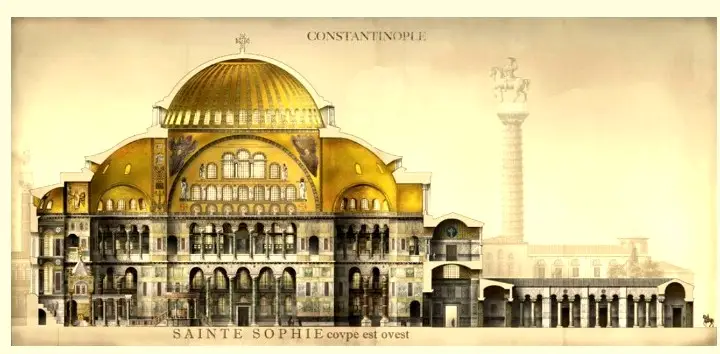
Saint Sophia. Modern reconstruction.
At that time, the cowardly Isaac, who accidentally found himself in power, was dying in the Grand Palace,
“thus, numerous predictions about his world dominion with his death ended in nothing and flew away like the dreams of a sick person.”
According to Nikita Choniates, he wanted, by agreement with Boniface of Montferrat, to bring the crusaders into the city to protect his son. In such a situation, a certain Nikolai Kanavos or Kanava, a relative of the Angels, was elected emperor in Hagia Sophia, "not devoid of military talent".
At the same time, Alexey Murzufl (Murzufl - Μούρτζουφλος), who was in the palace, decided to seize power. Murzufl turned to the Angles and Danes, the “Varangian Guard.” He outlined to them their sad fate if the crusaders won, and they helped carry out the coup. Alexei IV was arrested, he was slowly poisoned with poison, which did not work, since before that he had constantly taken the antidote, and the basileus elected in St. Sophia, Nikolai Kanava, was arrested.
As the logothete, the chief treasurer of the empire, Niketas Choniates, wrote: “But since the people of Constantinople (truth should be higher than love for compatriots) always gained an advantage over what was worse, Ducas gained the upper hand and became stronger, and Kanavos gradually lost its luster like the moon leaning towards damage.”
The intriguer Alexey Murzufl was not a supporter of publicity of power, making decisions privately, contrary to the legally established order. But it was very important for him to get rid of the crusaders. Therefore, to repair the city fortifications, he imposed tribute on the nobility. He himself gained popularity among the plebs because “many times, girded with a sword, with a copper mace in his hands, he either repelled enemy attacks with his own hands, or he himself bravely and unexpectedly attacked the enemies when they wandered scatteredly in search of food.”
And the crusaders scoured in search of food. The knights of Baudouin of Flanders occupied the city of Mosinople or Philae, which was located not far from Constantinople, as Villehardouin wrote, on the shores of the Russian Sea. Having eaten their fill and driven away the cattle, they returned to the camp in Galata.
Alexei organized an ambush on their way. On February 2, 1204, he attacked the rearguard of Henri, brother of Count Baudouin of Flanders. The battle began, but the Romans became timid and fled, leaving only Murzufla fighting. Despite the fact that the Byzantines had a numerical advantage, the knightly pressure decided the whole matter. The basileus himself escaped, but 20 of his best horsemen died: the Romans lost the imperial banner and icon.
And the crusaders again interpreted this event as evidence that God was on their side. Thus, Robert de Clari writes that it is impossible to lose a battle with the icon of the Mother of God, which means that it is in the hands of a usurper "does not work".
Murzufl told the townspeople that he had won, then the crusaders hung the royal regalia and icon on the high mast of the galley and showed them to the townspeople. From that time on, all services in the Crusader camp were held at the captured icon of the Mother of God.
Alexey V, realizing that it would be difficult for him to cope with the knights militarily, decided to negotiate with Dandolo. The Doge arrived on a trireme to the monastery of Cosmas and Damian, not far from the Blachernae Palace. The emperor was on horseback. The Venetian, insulting the basileus, demanded here and now to pay a fabulous 50 thousand centarii (centinarii) of gold and fulfill a number of other humiliating conditions for signing peace, in particular, to return Alexei IV, who was supported by the crusaders, to the throne.
But then a detachment of knights appeared, galloping at full speed, and the basileus was forced to flee. After this meeting, Murzufl ordered the strangulation of his nephew Alexios IV Angelos on February 8, 1204.
On March 10, 1204, the leaders of the Crusaders and Venetians began discussing how they would divide the Roman Empire. A document was signed according to which, if a Frenchman becomes emperor, then a Venetian should be the patriarch, and vice versa. In the capital, the future emperor separately received the palaces of Blachernae and Bucoleon.
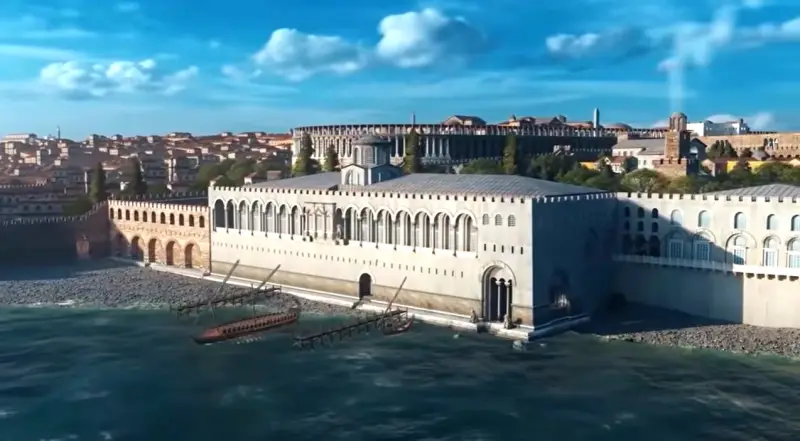
Bucoleon Palace. Modern reconstruction.
The rest of Byzantium was divided in half between the Franks and Venetians, where all knights would receive fiefs. The agreement, the leaders of the pilgrims believed, should have been approved by the Pope.
On the way to battle
The capital's residents actively restored the sea walls destroyed by the Venetians. They strengthened their tops with logs, built towers that had at least five or six tiers and were covered with skins to protect them from siege weapons, and 40 stone throwers were placed along the walls. After some time, there were already 60 stone throwers.
While the crusaders were making siege weapons. The Knight de Clary reported that the French had built a "cat", a type of stone thrower of enormous size. Which, most likely, was installed permanently opposite Petrion, on the southern side of the Golden Horn, where the width is maximum 700 m.
“Pigs” or “turtles” and “carts” were built for close-range damage to the walls.
The Venetians made floorings to place siege weapons on the decks, and protected the sides of ships with vines. They made siege bridges on the bows of ships and on the masts. Some ships had turrets installed.
There were a large number of pilgrims in the army who did not want to fight with their brothers in faith, so the priests agitated them and assured them that this was a just war, aimed at fighting those who had violated God’s and human laws.
So, April came, it was the third week of Lent. On Thursday, April 8, 1204, the loading of troops, horses and food onto ships began. Perhaps the pilgrims were afraid to leave him in the camp, or perhaps, in case of failure, they planned to flee.
The fleet lined up opposite the Sea Walls, it stretched 2 km from Blacherna, partially destroyed by a previous fire, to the Evergedite Monastery of the Virgin Mary, the location of which is unknown, approximately somewhere in the area of modern Phanar.
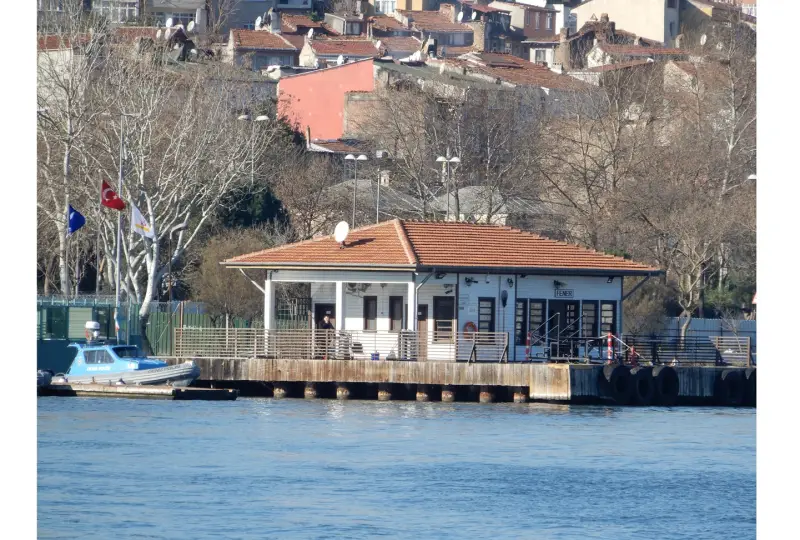
Fanar station on the Golden Horn. Istanbul. Türkiye. Photo by the author.
And Emperor Alexei set up an observation post, set up his camp and the imperial porphyry tent, as all chroniclers report, on the mound of the Pantepont monastery or on the fourth hill. From here the basileus could see the entire battlefield: the Golden Horn Bay with the Venetian fleet, and the Sea Walls. From here he could control his forces, redirecting them to particularly dangerous areas.
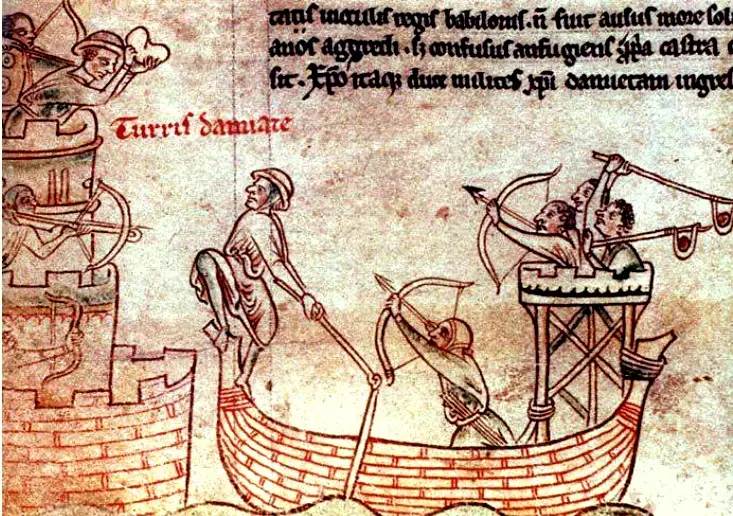
This is what a siege looked like at the beginning of the 1219th century. Siege of Damietta in Egypt 1240. Great chronicle of Matthew of Prague 1260–XNUMX. National library of France. Paris.
On Friday, April 9, 1204, the assault began from the naves and galleys. The naves approached the towers and walls facing the water, pulling the ships with ropes. And the assault began from the stairs of the ships:
“In many places the staircases of the naves came so close to the fortifications that those who were on the towers and walls, and those who were on the stairs, grappled with each other with the swords they held in their hands. So this attack continued, very fierce, and very strong, and very powerful, until nine o’clock and in more than a hundred places.”
And where they were at a distance, the landing began, the French brought “carts” and “turtles” to the walls. On the hill, the emperor's troops blew silver trumpets and beat drums, drowning out the roar of battle.
The townspeople unleashed a barrage of shells on the besiegers; Robert de Clari reports that huge blocks of stone were thrown from the walls, which were smashed to pieces by the Frankish siege weapons. And the assault died down and the retreat began. Due to the confusion, stones from mangonels and stone throwers installed on ships anchored in the bay fell into the ships that picked up the landing party.
As a result, the Latins had heavy losses, and the Romans had fun on the towers, showing the shameful places to the retreaters. At the imperial headquarters they blew trumpets and beat drums. Alexei V, who had recently seized power, told the townspeople that this victory showed who the real emperor was, who could defeat and punish his enemies.
The pilgrims attributed their failure to God's will and their sins. In the camp of the invaders, despondency set in; ordinary crusaders believed that their defeat was due to the fact that God was punishing them for attacking Christians, so the entire numerous clergy began to actively convince ordinary knights that the fight was not with Christians, but with the usurper and schismatics who refused submit to the Holy See in Rome.
After prayers at the military council in the monastery of St. Cosmas and Damian, a proposal was made to storm the city to the east, where the fortifications were weaker, but the Venetians, “well-versed in maritime affairs,” noted that the current would carry away the ships. However, as “Marshal” Champagne claimed, there were many among the soldiers who wanted to “fly away” from these walls to far away.
It was decided to launch a new assault in two days, and to increase pressure on the defenders of the towers, the attack should be launched from two naves at once, connected by ropes.
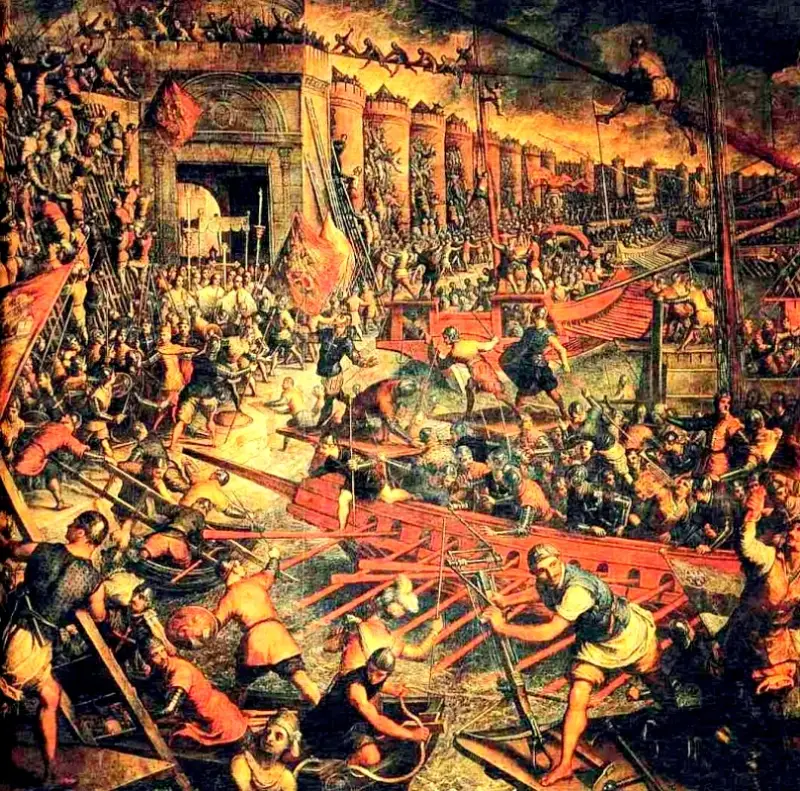
This is what the siege of cities by Venetian “traders” looked like in the 16th century. This is what G. Tintoretto depicted, calling the painting “The Siege of Constantinople.” Located in the Doge's Palace in Venice.
The last battle
On April 12, a new assault began in the morning. Everything happened the same as the previous time. The Constantinople soldiers, confident in their numerical superiority, fought bravely. The naves could not really approach the walls and towers that faced the sea.
But then Boreas, the north wind, blew. Once in the case of the siege of the Avars, on August 6, 626, he drove the same-tree Slavs to the southern bank of the Golden Horn in the same places, defeating them. But the naves are not single-shafted, they were washed close to the shore, and the knights began the assault. Gunther Perry wrote:
Ships with the iconic names “Pilgrim” and “Paradise”, tied with a rope, “wind and God” were placed close to the sea tower. The Venetian Petro Alberti immediately jumped onto the tower, but the Angles, Danes and Romans chopped him down with axes. And the wave threw the unsecured ships back and rolled onto the tower again. The ships belonged to the bishops of Soissons and Troyes.
Now the knight Andre Durboise, repeating the feat of the Venetian, grabbed the tower with his hands and feet and climbed onto the upper tier. He alone, dressed in chain mail, found himself on the tower. Taking out his sword, the knight attacked the defenders, and they fled to the level below. Knight Jean de Choisy climbed the tower behind him. They secured the nave securely to the tower, so that it seemed to sway with the nave. Soon the top of the tower was filled with Frenchmen.
At the same time, 10 knights and 60 squires, under the command of the well-known Pierre of Amienois, landed at the neighboring wall. Noticing that there was a weakly sealed gap in the wall, they began to hit it with spears. The besieged threw stones at them. When the pilgrims reached their goal, through the gap they saw a huge number of warriors standing behind the wall and did not dare to attack.
But the cleric Alhomme de Clari single-handedly attacked the Romans, and they retreated. It was Robert's brother who fought in this detachment and described the siege of Constantinople.
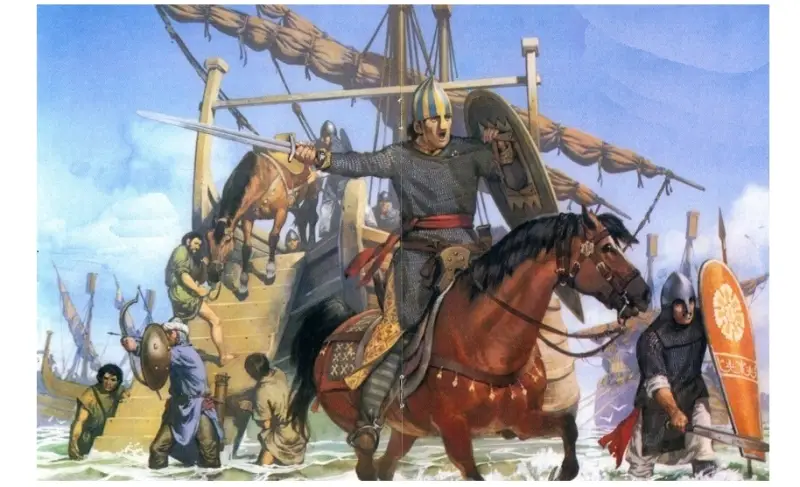
Landing of the Sicilian Normans. XII century Osprey Publishing.
Behind the cleric, the entire foot detachment entered the gap, finding themselves directly in the line of attack of the horsemen of the Basileus of the Romans. Realizing that there were no options, the knights prepared for battle, ready to sell their lives dearly, but the horsemen stopped the attack, turned around and left the battlefield.
Then the Franks ran to the nearest gate and smashed it with axes, opening the way to the city for the entire army. Horses were brought out from the Yuissiers, who had approached the edge of the ground in front of the walls, and the knights saddled them.
This was the climax of the siege. At the head of the knightly cavalry was Pierre de Brassier, a warrior admired by both enemies and friends. Here is what Choniates writes:
Despite the fact that the hills behind the Sea Walls were fortified and were the second line of defense, they were abandoned by the defenders, the troops fled and scattered throughout the territory of the huge capital, a large number of warriors rushed out of the city.
Pierre de Brassier captured the imperial scarf and treasury, the knights began killing and robbing, the Italians expelled the previous year especially distinguished themselves, taking revenge on the Byzantines. They set fire to the northeastern part of the city. In the evening, the Latins gathered at the Pantepoptsky monastery, setting up their camp here, where the emperor’s headquarters had previously been.
And the emperor rushed around the city, trying to gather forces for defense. But the warriors and male population of the capital, many times larger than the army of pilgrims, were not ready to fight, preferring to flee.
To be continued ...
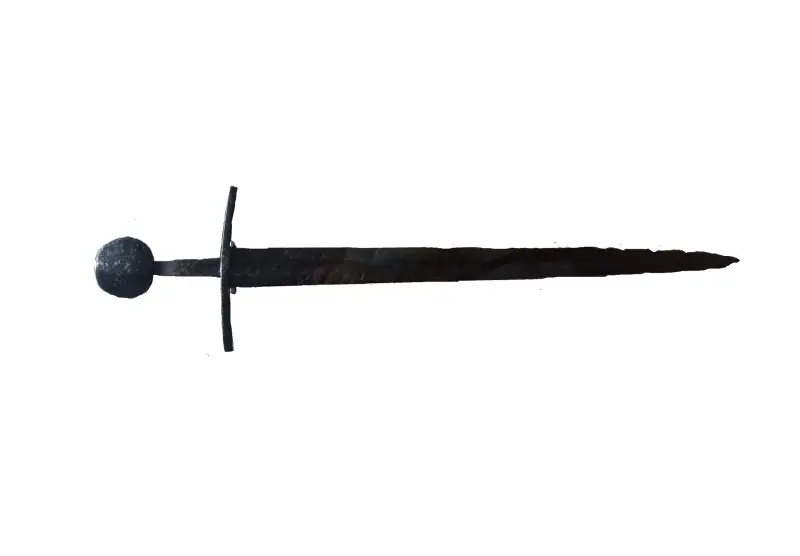
Information